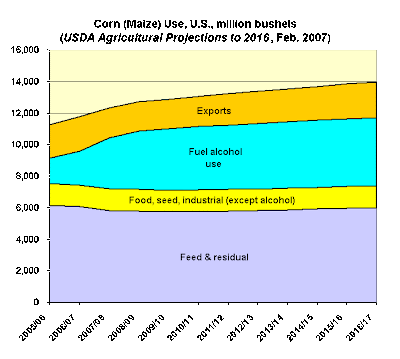Ethanol Changes Corn Market, But Doesn't Reduce Petroleum Use
An increasing fraction of the U.S. corn (maize) crop is being converted to fuel alcohol, with predictable effects on U.S. Agriculture: higher corn prices (as shown in the chart above), higher meat prices, and more money in farmers' pockets.
The map below shows the location of current ethanol plants (green dots) and plants under construction or expansion (yellow dots). As you can see, capacity is going to about double over the next few years.
The two charts below show USDA projections for corn use and corn prices over the next ten years. The production of corn will increase, responding to the higher price. Virtually all the additional corn will be converted to ethanol. Much of this additional corn production will come at the expense of soybean planting, and will therefore decrease the production of soybeans. (Biodiesel production will have an additional effect, to be discussed in another post.)
The fraction of the U.S. corn crop used to make fuel ethanol is projected to more than double over the next few years, from 14% to more than 30%.


Little to No Impact on Fossil Petroleum Use
In spite of this apparent surge in ethanol production from corn, the proportion of total petroleum use that will be supplied by ethanol will only grow from 1% to 2% over the next ten years. (See data at the Energy Information Administration: Renewables Consumption By Sector and Petroleum Supply and Demand.)Unless we change our ways, we will be burning more oil ten years from now than we burn today.


No comments:
Post a Comment